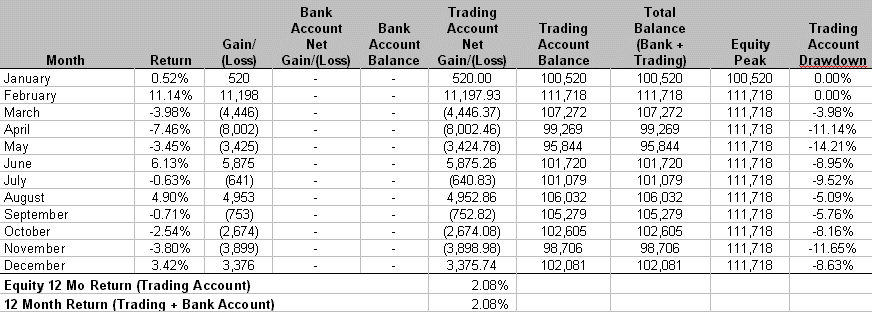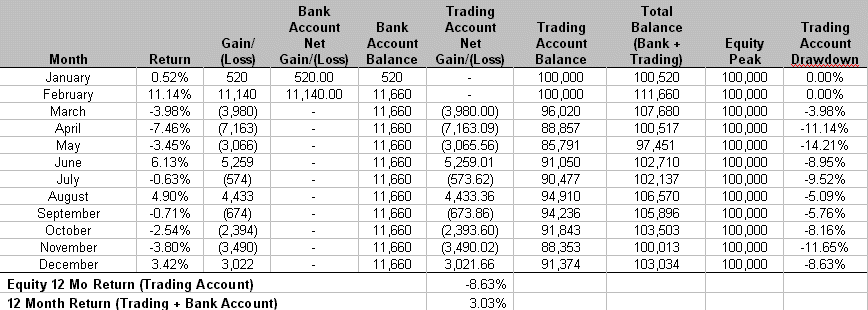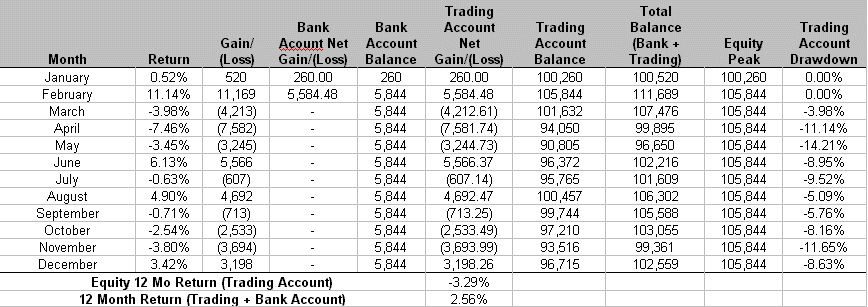Taking Money Out Of The Market
Money
management is one of the most important aspects of
trading and can make or break a strategy. Typically,
when we think of money management, we think of position sizing, stop losses, and
profit taking. One of Linda Bradford
Raschke’s money management rules that I find interesting is: “Split
your profits right down the middle and never risk more than 50% of them again in
the market.â€Â
How can you take
this concept and apply it to your own trading? Here
are two approaches:Â
- Fix
your account size. First,
you might consider fixing your trading account at a certain dollar amount,
let’s say $100,000. At the
end of the week, if your account exceeds this amount you have a plan in
place to call your broker and instruct them to cut you a check for the
difference.Â
If you are in a drawdown, and your account is below $100,000 at the
end of the week, you do nothing until it exceeds this amount at the end of
the week.A word on position sizing: Â Â If
you use this approach, you should size your positions based on the lesser of
current equity or fixed account size ($100,000 in this example).Â
What do I mean? Furthermore,
you typically risk 1% of equity per trade.Â
In this instance, base your 1% of equity on your fixed account size
($100,000) not your current equity ($110,000).Â
If you use current equity, you are going to end up with an oversized
position at the end of the week, when you bank your profits and your equity
returns to $100,000.A more conservative method would be to use the lesser of current equity,
last week’s closing equity, or fixed account size.
- Take
partial withdrawals. You
may not be the type of person who wants to remove all of your profits from
your trading account. Instead,
you may be comfortable risking a portion of your gains in the market again
and (hopefully) allowing them to compound.Â
For example, you might choose to leave 50% of your profits in the
trading account. Let’s say
that you make $2000 in a week — at the close of trading on Friday, you
would instruct your broker to cut you a check for $1000.Â
Now, $101,000 becomes your new equity peak.Â
If your account exceeds $101,000 at the end of next week, you will
remove half of the difference. If
your account is below $101,000 you do nothing.Â
Repeat the process until you are filthy rich.A word on position sizing:Â Â To
size positions using this approach, one might exclude half of the profits
from position sizing calculations. Using
the example above, if you made $2000 in profit positions would be sized off
of $101,000 in equity.A conservative method for sizing positions here would be to use the lesser
of current equity less half of profits or last week’s closing equity.
Now, let’s take a
look at an example of how these strategies might affect performance.Â
For performance numbers, I’ve chosen the monthly returns of the CSFB
Tremont Long/Short Equity Hedge Fund Index (phew!) for 2000.Â
I chose 2000 because that was the last time the index had a positive
year.
For the sake of this
example, I will use monthly data, which is all that’s available, and assume
that profits, if they are swept, are swept out of the trading account at the end
of the month.
Here are the returns
we will work with:
| Month
|
Return
|
| January
|
0.52%
|
| February
|
11.14%
|
| March
|
-3.98%
|
| April
|
-7.46%
|
| May
|
-3.45%
|
| June
|
6.13%
|
| July
|
-0.63%
|
| August
|
4.90%
|
| September
|
-0.71%
|
| October
|
-2.54%
|
| November
|
-3.80%
|
| December
|
3.42%
|
| Total
|
2.08%
|
Here is what returns
would have looked like assuming all profits were kept in the trading account
(signified by Bank%:0):
Starting
Capital: $100,000
Ending
Total Capital (Bank + Trading): $102,081
Bank
%: 0%
Total
Banked: $0
12
Month Return on Trading Account: 2.08%
12
Month Total Return (Bank + Trading): 2.08%
 
Now let’s take a
look at how banking 100% of profits would have affected the bank account,
trading account, and total performance:
Starting
Capital: $100,000
Ending
Total Capital (Bank + Trading): $103,034
Bank
%: 100%
Total
Banked: $11,660
12
Month Return on Trading Account: -8.63%
12
Month Total Return (Bank + Trading): 3.03%
 Â
Â
Under this scenario,
you were able to bank $11,660 of trading profits.Â
The most interesting number, in my opinion is that the Total 12 Month
Return is 3.03% (vs. 2.08%). Also,
you’ll notice that the Trading Account is in an 8.63% drawdown as indicated by
12 Month Return on Trading Account. However,
this drawdown is identical to the drawdown under the first scenario where no
profits were banked.Â
Lastly, let’s
examine the effect of banking 50% of profits:
Starting
Capital: $100,000
Ending
Total Capital (Bank + Trading): $102,559
Bank
%: 50%
Total
Banked: $5,844
12
Month Return on Trading Account: -3.29%
12
Month Total Return (Bank + Trading): 2.56%
 
Â
As one might expect,
the results are between banking nothing and banking everything.Â
You were able to put away $5,844 in this scenario.Â
Total Return was 2.56%, which is better than 2.08% and not quite as nice
as 3.03%.
Conclusion
Not every scenario
will work out like the above example. If
you have a year where you go into an immediate drawdown and can’t seem to dig
yourself out, you may never bank profits. On
the other hand, if you have a year where your returns are parabolic, you will
have wished that you had left all of your profits in to be compounded.
Reality lies somewhere between these two.Good Trading,
Michael
P.S. If you have any
questions, please feel free to email me at workstation@demaray.net
Michael
Demaray is making a go at being full time trader from his home in Chicago. He focuses on swing trading
stocks using the momentum methods of Dave Landry. His previous experiences
include starting a hedge fund, strategy consulting, and a stint as the Manager
of Business Development for Pets.com.
